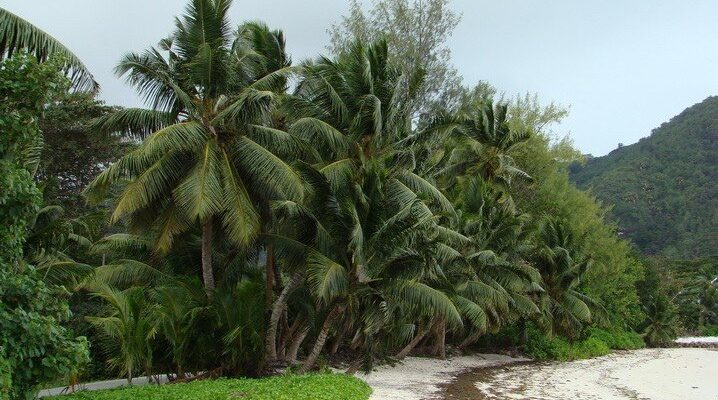Praslin Island
Praslin is the second largest island of Seychelles, located in the Indian Ocean, 44 km northeast of Mahé. Gorgeous clean beaches, a unique rain forest and a sparse town of 7,500 people make the island ideal for a secluded luxury vacation. Praslin is also famous for the coco de mer nut, the symbol of Seychelles.
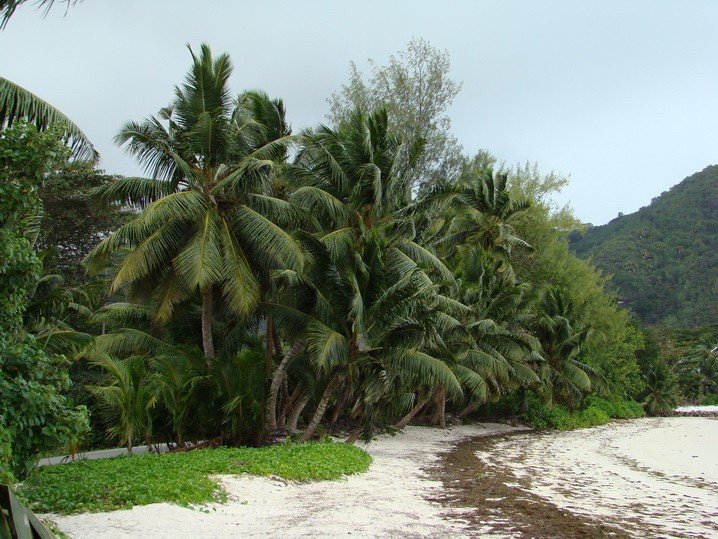
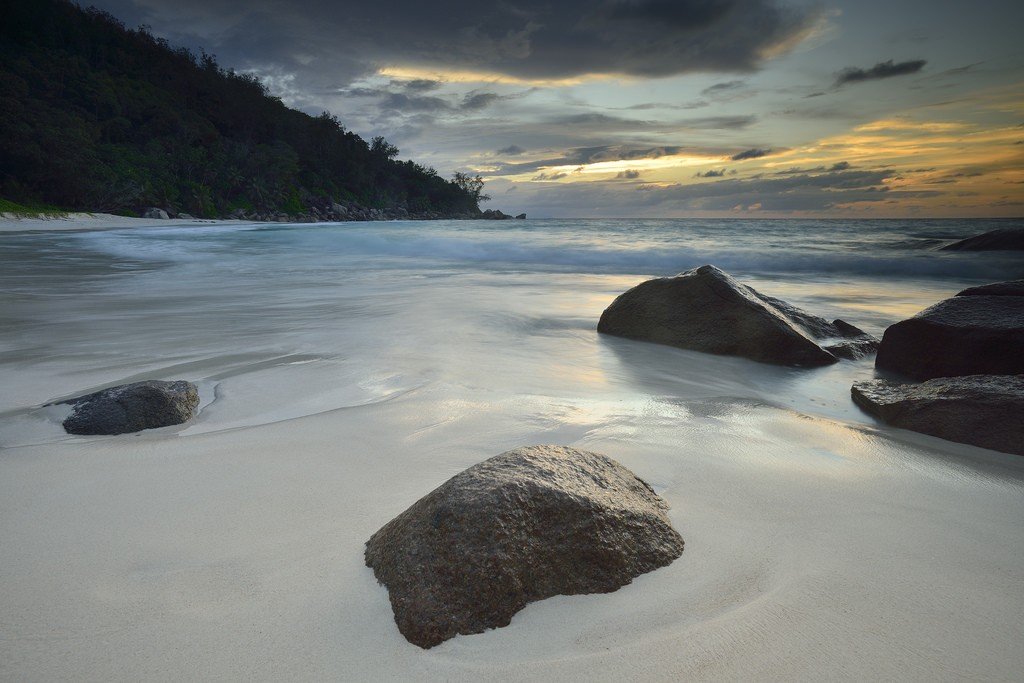
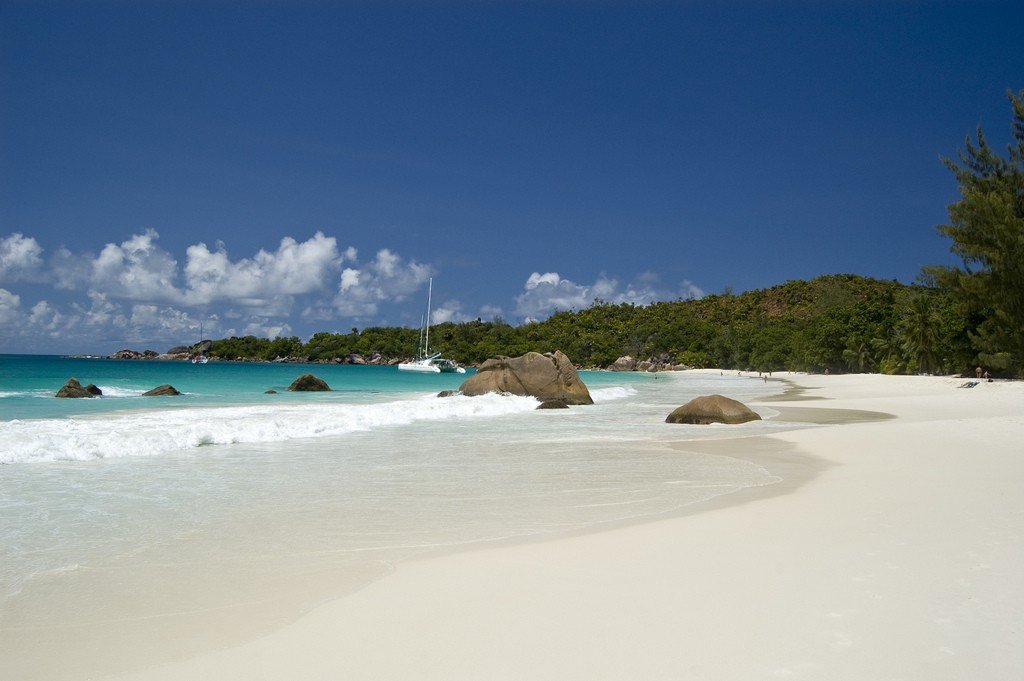
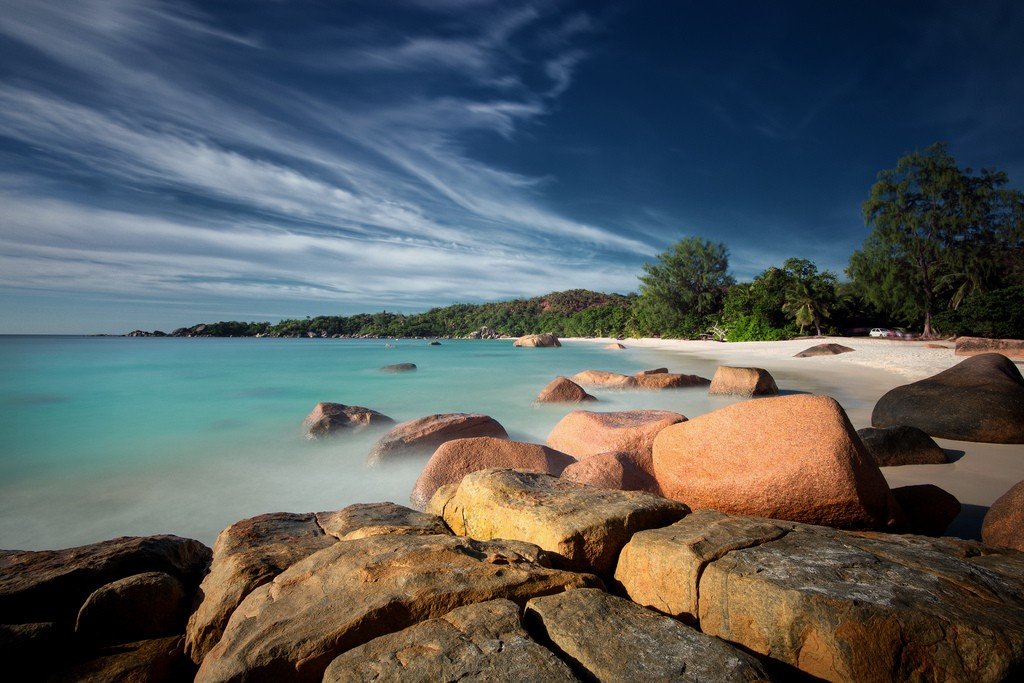
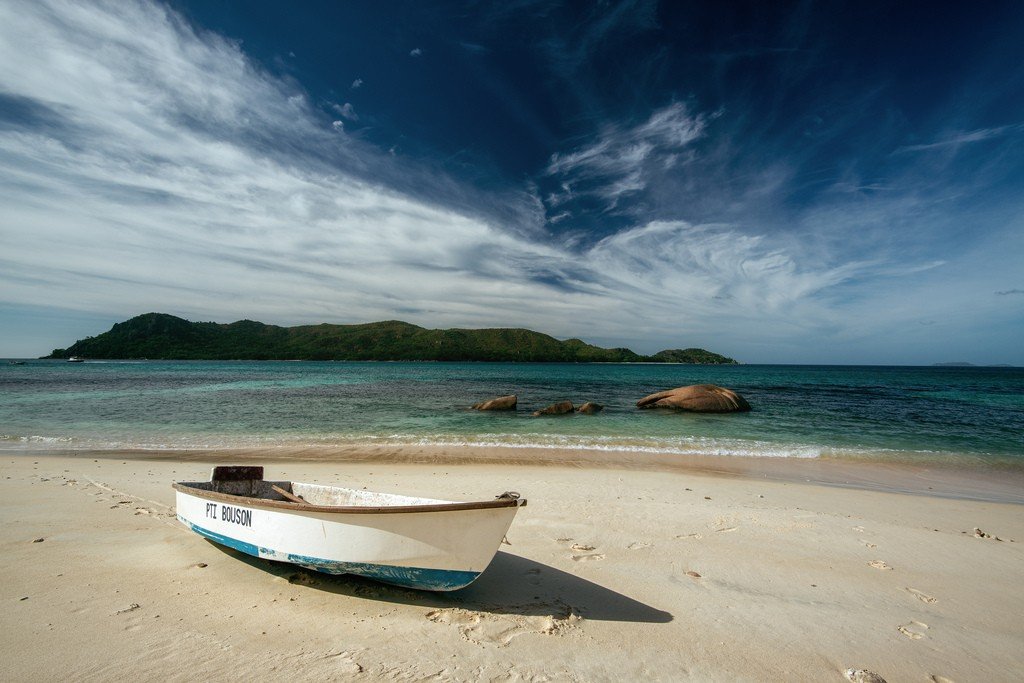
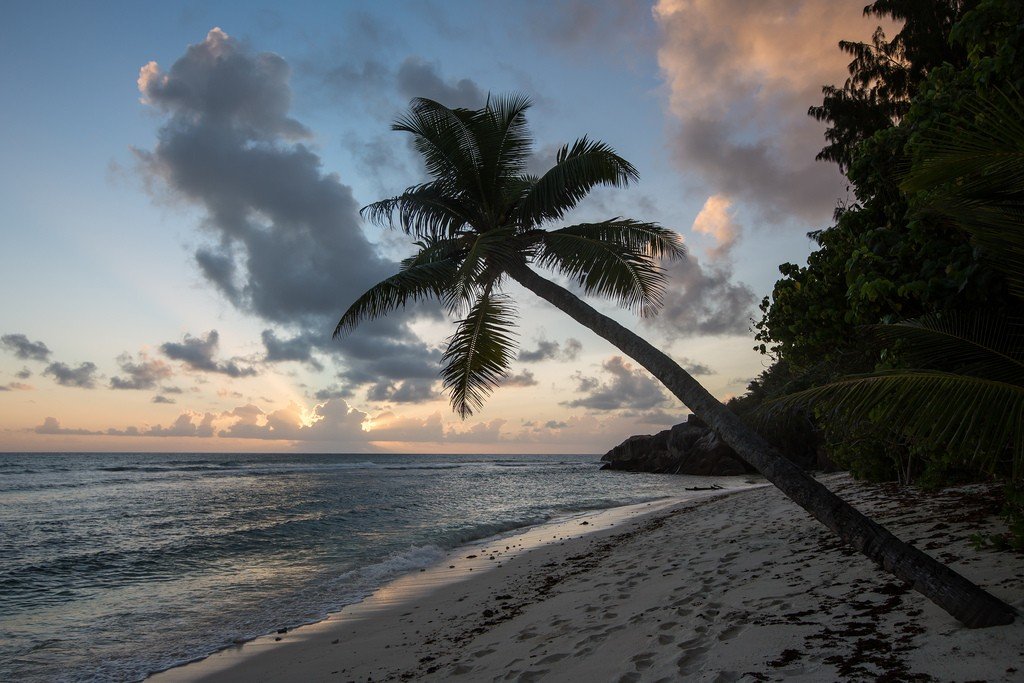
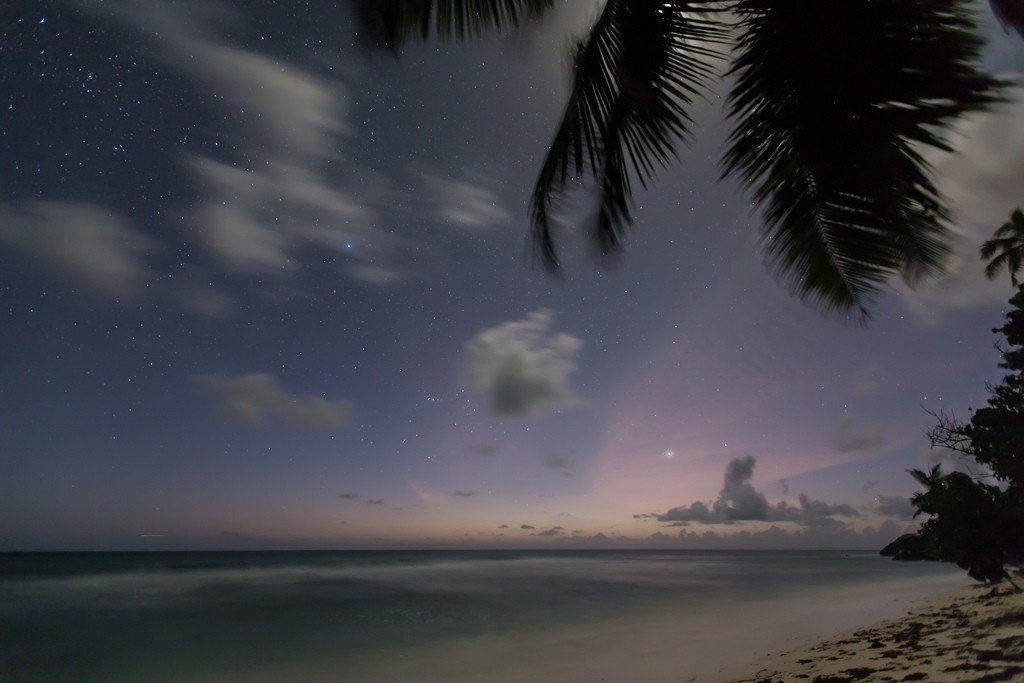
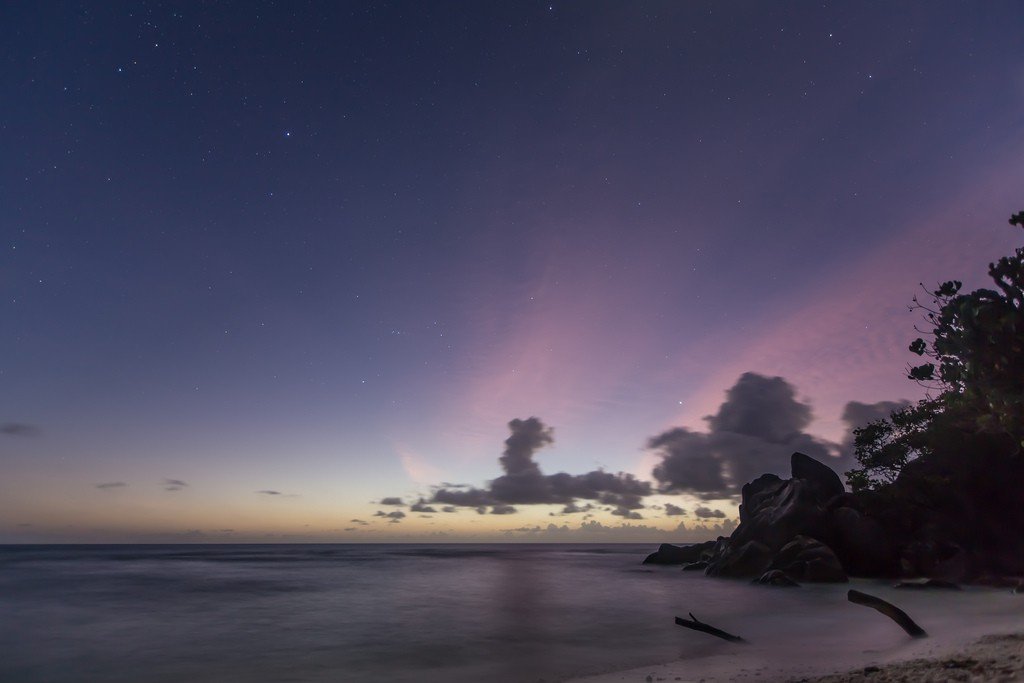
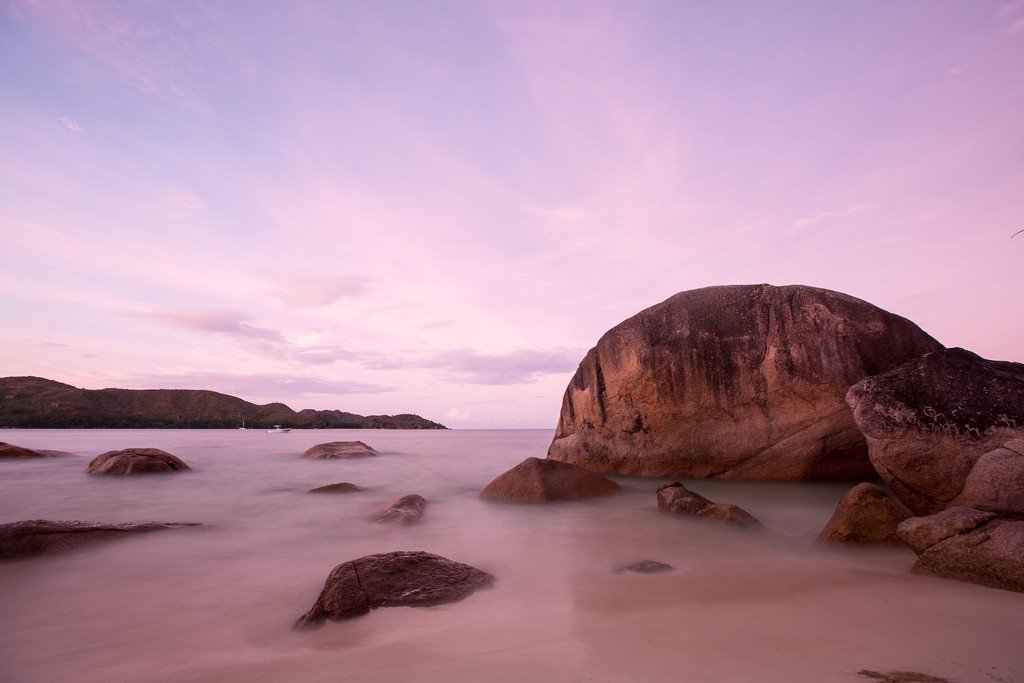
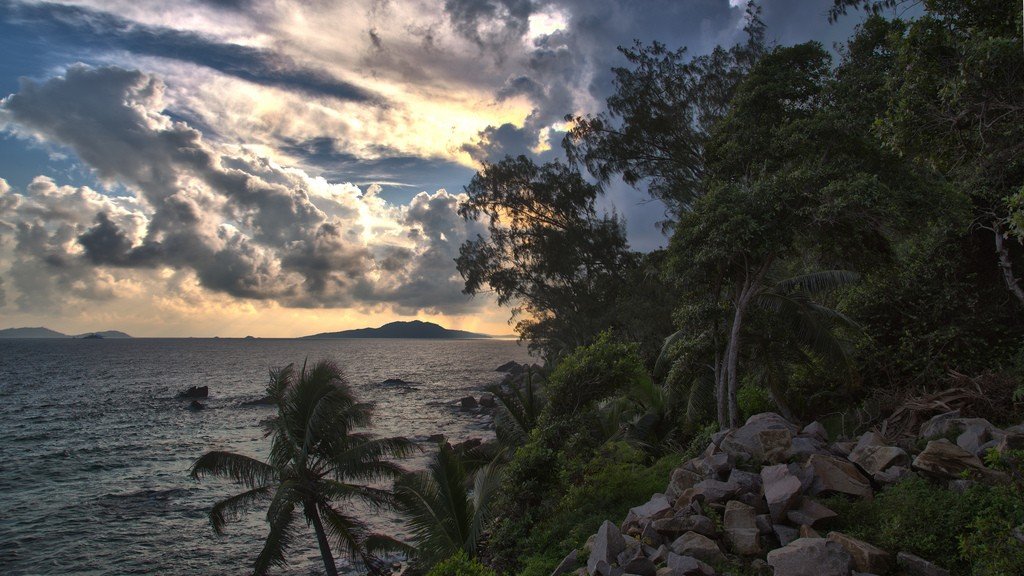
Video: Praslin Island
Contents- Highlights
- History of Praslin
- When is the best time to go
- A walk through the nature park of Valle- de Mae
- Praslin beaches
- Neighboring islands
- Local cuisine
- Where to stay
- How to get there
Highlights
The island of Praslin covers an area of 38.52 km². Administratively, it is divided into 2 districts, Be Saint-Anne and Grande Anse. Whether you arrive on Praslin by air or sea, it is immediately apparent to you that the second largest inland island of Seychelles is not as mountainous or as populated as Mahe. Most of the islanders are involved in fishing, agriculture, working in the tourist industry or commerce.
.
Praslin offers accommodation to suit all tastes and tastes. There are many excellent restaurants and cafes and excellent roads. For a real islander feel, take the shabby buses, where your neighbors will be cheerful children and cheerful grandmothers.
.
Praslin’s main attractions are the Vallee de Me valley, a primeval rain forest of coco de mer palms, and the luxurious Anse Lazio beach to the north. From Praslin you can hike to the islands of Curieuse, Cousin and Arid – great spots for nature lovers. There are a couple of offshore islets near them, including Round Island (0.193 km²) and Shove Suris (0.007 km²), which have hotel rooms.
.History of Praslin
In 1744, explorer Lazare Picot named the place Isle de Palmes – “island of palms”. In the 18th century, the island was used as a hideout by pirates and Arab merchants. In 1768, it was renamed Praslin in honor of French diplomat César Gabriel de Choiseul, the Duke of Praslin.
.The island is home to rainforests that are home to rare birds such as the native Seychelles bulbul and black parrot. The Vallée de Me Reserve, established in 1979, is known for its unique coconut and vanilla orchids. One of the most famous British generals of the 19th century, Charles George Gordon, believed that the Vallee de Mae was Eden, the Garden of Eden from the Bible.
.When is the best time to go
Vacation in Praslin is comfortable all year round, as the air warms up to +25…+27 ° C, and the water temperature does not fall below +23 ° C. Low tourist season is considered to be the time from November to March, except for New Year vacations. During this period, the probability of showers is higher than in summer, but the precipitation does not cause serious discomfort. Usually Praslin is less rainy than neighboring Mahe, which makes it more popular with tourists in winter. From April to October the island is in high season, the weather is slightly cooler and rains are rare. The peak of attendance is in July and August, which is associated with summer vacations.
.
Choosing the best time to travel to Praslin is recommended based on how you would like to spend your time here. Snorkeling and sailing can be enjoyed here all year round. For surfing and windsurfing the period from May to September is the best. The same time is considered the best for hiking in the reserve. Unforgettable diving is guaranteed from March to May and from September to November, and fishing from October to April. If you want to watch birds, you’ll have to prioritize your time – April is breeding season, May-September is nesting season for dry terns, and October is migration time.
.A walk through the Vallee de Me Nature Park
The Vallée de Mae Nature Reserve covers an area of 19.5 hectares. The valley is located in the eastern part of Praslin Island. In 1983, the park was designated a UNESCO World Heritage Site. It is the only place on the planet where the Seychelles coco de mer palm trees, whose seeds are the largest of all plants, as well as 5 other endemic palm species grow. The rain forest has not changed its appearance since primitive times, i.e. for more than two million years.
.
The fauna of the reserve is represented by endemic species of birds, mammals, crustaceans, snails and reptiles. The Vallee de Me is home to the black parrot Coracopsis nigra barklyi, which lives only in the park’s palm forest. Other endemics of Praslin are the Seychelles bulbul, the blue dove, the Seychelles nectarbird, and the salangana. Among mammals, there are two native species, the Seychelles flying fox and the bat. It is also interesting to see Chamaeleo tigris, a unique chameleon.
.The route along the Vallee de Me is about 1 km long. It is best to do the walk in the morning when it is not so hot. The journey will take approximately 1-2 hours.
.1. Entrance
Walk up a few uneven steps to the entrance where they check tickets. This is necessary to check that no one has stayed in the valley overnight. A small kiosk near the entrance is a great place to relax and get into the appropriate mood. Smoking is strictly prohibited in the valley. You may see rare birds such as black parrots or insect-eating tenrecs scurrying around under the trees.
.Opening hours: 8.00-17.00. Entrance is paid – 350 rupees per person. Bus: No. 63 from Be-Saint-Anne, Grande-Anse and Côte d’Or. The stop is near the tourist center. If you are coming in your own car, you can leave it in the parking lot in front of the center.
. The road goes to the top. At the fork, turn right at the North Trail sign. The trail will lead you to the edge of the woods..
2. Fire barrier and the edge of the forest
Here you will see sprouts of young coco de mer palms poking up out of the ground. They have leaves on long petioles but no stem. Marker E on the right is a fire barrier. It was created in 1990 after a severe fire that killed many palm trees. The barrier consists of fire resistant Kalis dipap trees and other ornamental and fruit trees. Go further north and the trail will take you to marker C at the granite boulders. Listen for babbling brooks and continue on. At the next marker, turn left onto the Cedar Path, which will lead you into the palm forest.
.3. coco de mer palm forest
In this primitive forest, you will feel as if you are in another world. Giant fan leaves cover the sky. The only sound is the rustling of palm leaves in the wind. Many palm trees are over 200 years old. They thrive on fertile soil fertilized by fallen leaves. Notice the long earrings of male palms and the massive oval nuts of female palms. The nuts weigh up to 20 kilograms. Female palms are shorter than male palms.
.At the next marker, turn left and follow the trail signposted “Cedar Path.”
.4. Cedar Path
On the right you will see a small creek with a rocky bottom. This creek and several others merge to form a waterfall. The waterfall, which is located 400 meters southwest of Valle de Me, provides water for the entire west coast of Praslin. Look closely and you’ll see freshwater crabs and transparent shrimps. Moths and brightly colored dragonflies flutter over the water.
.Follow the Cedar Trail and turn left onto the Center Trail.
.5. Center Trail
To the right of the Center Trail is a ravine where magnificent pandanus trees grow. Some palms are peacefully neighboring philodendrons, but they are a weed that is ruthlessly eradicated. Depending on the season, you will see fruit and ornamental trees in bloom. The valley is home to endemic birds such as nectarbirds, bluebirds, black parrots and bulbuli. Follow the Central Trail to the park’s exit.
.Praslin Beaches
Anse Kerlan, Petite Anse Kerlan, and Anse Georgette
The three beaches are located on the northwestern tip of Praslin, west of Grand Anse Airport. From September to February, sea turtles lay their eggs here. Anse Kerlan is the longest beach, a flat stretch of white sand with smooth boulders bordered by takamaka trees. To the north are the luxurious villas of the Lemuria Resort Hotel. Nearby is the small, secluded beach of Petit Anse Kerlan, where the hotel’s boat station is located. From here, Anse Georgette can be accessed along the coast.
.The Lemuria Resort is home to the Seychelles’ only 18-hole golf course. If you are a guest of the hotel, you can walk along the golf course, admiring the streams and lakes, and walk out to Anse Georgette. If the hotel is not full, you will be allowed in. But it’s best to clarify this in advance. From the golf course, it’s a 20-minute walk to the plateau, where you’ll have great views of Cousin and private Cousin Island. From the 15th hole you can see the beautiful panorama of Anse Georgette.
.Anse Lazio
This picturesque bay is the quintessential Seychelles beach: soft fine sand, crystal clear sea, smooth granite boulders, wind-bent palms and takamaka trees along the beach. Travel magazines are overflowing with raves about this place. Fashion magazines shoot here all the time. In the 1980s, the movie Shipwrecked, based on Lucy Irwin’s book about life on a desert island, was filmed on this beach. Weekdays are a great time to swim, relax and snorkel. There is a good parking lot and two restaurants on the beach. Anse Lazio is 800m northwest of Anse Boudin, on the north coast of Praslin. Buses run from Vallee de Me via Be St Anne and Côte d’Or and stop at Anse Boudin. From here you’ll reach the beach in 15 minutes. If you don’t feel like walking, you can take a cab.
.Anse Marie-Louise
Anse Marie-Louise is located 8 km southeast of Grand Anse. It is the most picturesque of the eight beaches on the south coast from Grande-Anse in the west to Be-Saint-Anne in the east. Tourists enjoy spending time on this wonderful beach, swimming in the ocean or having a small picnic. From the main Grande Anse road, you should turn off before the trail begins to climb steeply to the Chateau de Feuilles Hotel at Poin Cabris. The hotel is a great place to relax, have something to drink and take in the magnificent views.
.Anse Possession
Anse Possession is a beautiful deep bay with many small coves covering Curieuse Island. The beach is located Z km northwest of Anse Volbert on the Côte d’Or. In 1768, the French declared Praslin their possession and marked the fact with a lead plaque. An English naval officer tore down the plaque and erected his own in its place. Today it is a quiet, peaceful resort with several hotels. Anse Posesyon beach is an ideal picnic spot. To the east, on the beach of Anse Petit Coeur, is the La Reserve Hotel. The hotel was completely destroyed by the tsunami in 2004 and opened after rebuilding in 2006.
Baie Sainte Anne
This small fishing village is experiencing a renaissance. A very promising reclamation project is underway here – the creation of the artificial island of Eve. This will allow the coast to cope with the growing flow of passenger and cargo ships from Mahe. Tourists arrive at the pier, located in the southern part of the bay, and from there they travel by cab and bus to their hotels. It’s a great place to experience the relaxed pace of tropical life, chatting with fishermen and locals at the market. The narrow beach is fringed with trees that provide pleasant shade. The village has several banks, stores and Praslin’s only hospital.
.Be Saint-Anne is located in the southeast of Praslin. Buses run between the beaches of Côte d’Or, Vallee de Mae, Petit Anse and Be-Saint-Anne without a timetable.
.
Cote d’Or or Anse Volbert
Praslin’s main tourist beach is 2 kilometers of white sand, shallow sea and picturesque palm trees. Côte d’Or is located on the north coast of Praslin, halfway between Anse Posesyon and Anse Matlo. It is a true paradise for families with children. The main life takes place in Anse Volbert, a small town with many hotels, inns, stores, restaurants and casinos. The town is completely immersed in tropical vegetation. When the southeast monsoon blows, the southern shores of the island are covered with seaweed and tourists flock here. You can take a boat trip to the islets of Chauvet Suri or St. Pierre, spend a day on Curieuse, Cousin or Arida. You can rent a bicycle in some places.
.Grande Anse
Grande Anse is a small, lively resort similar to Be-Saint-Anse and Côte d’Or. The beach occupies the south coast, 3 km east of the airport at Amiti. Most tour operators are based here. From the airport here you can get here in just a few minutes. The resort offers a variety of accommodation options from hotels to small guesthouses. The local cafes have a characteristically Seychellois atmosphere. Like everywhere else on Praslin, there is not much entertainment here. On Friday and Saturday, locals of all ages head to Café Briz for refreshments before continuing to relax at the Oxygen nightclub in Be St. Anne.
.From Grande-Anse, buses go to Vallée de Mae in the center of the island or to the south coast, where the beaches of Anse Citron, Anse Bateau, Anse Saint-Sauveur, Anse Takamaka, Anse Simetière, Anse Bois de Rose and Anse Consolation are located. It’s not the best place to swim, but the golden sand and smooth brown boulders are very picturesque and worth a visit. The Indian Ocean Lodge in Grand Anse and Coco de Meg in Anse Bois de Rose offer complimentary shuttle service to the beaches of the Côte d’Or. This service is especially popular from May through September, when the southern shores are covered with seaweed.
Neighboring Islands
La Digue Island
To the southeast of Praslin is the island of La Digue. It takes about 15 minutes to get here by boat. La Digue is considered one of the most picturesque islands of the Seychelles archipelago. Most of the area is covered with jungle, as well as coconut and cinnamon plantations. On La Digue, travelers enjoy the pristine beauty of nature, visit Anse Sours D’Arjan, one of the most photographed beaches in the world, Union Estate Park, and a flycatcher reserve. The island is home to a farm with giant tortoises, which can be over a hundred years old.
Tourism is the main source of income for the local population. There are no paved roads on La Digue, so islanders travel mainly by ox-drawn carts or bicycles. Tourists often rent bicycles to get around La Digue in half a day..Aride Special Nature Reserve
Aride Island has an area of 68 hectares. The nature reserve is located on granite islands where many rare birds and unique plants can be seen. In 1973, the northernmost of the granite islands was purchased by the “chocolate king” Christopher Cadbury and given to the Royal Society for the Conservation of Nature, creating a natural paradise.
In good weather, ships dock at La Cour beach. Getting off the beach is not easy – there is no jetty on the island and tourists have to jump into boats to get to the shore. Carefully pack everything valuable in film, wear shorts or swimsuits and stock up on sturdy, comfortable shoes, as the paths on Arida are steep, uneven and slippery after rain. Bring water and something to eat – there are no cafes or restaurants on the island.
.
Arid Island is managed by the Society for the Protection of the Environment. Caretakers are always on duty at the visitor center, from where a hiking trail begins, passing through the coconut plantation and village and out to the coast. Note the rare Seychelles warbler, which was once on the brink of extinction. After 29 birds were relocated from Cousin Island to Arid, these birds are no longer in danger of extinction. To the west the trail becomes very steep, but here you can see the burrows where the wedge-tailed petrels live.
.The guide will show you the local cucumber, which blooms only at night, and Wright’s gardenia, a flower that grows only on this island. Famous musician George Harrison planted the Wright’s gardenia at the Mahe Botanical Gardens in 2000, but the plant died shortly after his death. No attempt to transfer the gardenia to other Seychelles islands has been successful. The flowers of the gardenia are white and the petals are covered with thin pink strokes.
.
Arida is home to a huge number of lizards and birds sing here all year round. Small silly terns and dark terns can be seen on the island from March to November; pink terns appear from April to August, and the rest of the time you will encounter three unique Seychellois bird species – nectarbirds, bluebirds and magpie warblers, as well as giant frigates and red-tailed phaetons.
La Cour beach is a great place to swim, snorkel or have a small barbecue, a service offered by local tour operators and guides. The reef is home to hundreds of fish, but be mindful of the strong currents.
The boat trip from Côte d’Or on Praslin to Arida takes 45 minutes. Excursions from May to September are arranged depending on weather conditions.
.
Cousin Island Nature Reserve
Cousin Island has an area of 28 hectares. Visiting this reserve is one of the most popular excursions in Praslin. From Bé Saint-Anne you will reach the island in half an hour, the journey from Côte d’Or will take a little longer. The boats stop fairly close to the shore, and tourists are ferried to the island in small boats. You’ll inevitably get your feet wet during disembarkation, so it’s wise to wear shorts or swimsuits and pack cameras and other valuables in plastic bags.
.At Cousin, you’ll be met by a guide who will give you a half-hour tour. The reserve is managed by Nature Seychelles. It is a paradise for birdwatching enthusiasts and naturalists. Some of Seychelles’ rarest birds can be seen here, including the Seychelles warbler, which was recently listed as an endangered species. Cousin is also home to magpie warblers, Seychelles fowls and Madagascar turtledoves. Little Foolish Terns appear on the island during the southeast monsoon, and White Terns can be found here year-round.
.Before the Royal Society for the Conservation of Nature purchased the island, Cousin was a coconut plantation. Nowadays, wild cotton, papaya and pincushion can be seen here. The only footprints in the sand are the paw prints of geckos, millipedes, giant tortoises and two species of skinks. From October through March, bissoid turtles lay their eggs on the beach.
.
To Cousin Island, catamarans depart from Baie-Saint-Anne. The standard excursion also includes lunch, a visit to Curieuse, swimming on St. Pierre Island, and a fee to ferry to the islands.
.
Cousine Island
This tiny private island is just south of Cousine. Honeymooners looking for total privacy love to come here. Even Sir Paul McCartney has vacationed here. At the same time on the island can be no more than ten people who live in four colonial villas on the beach. The main entertainment is birdwatching in the private reserve, home to five endemic bird species, or snorkeling and meeting colorful marine life.
.Private transfers to Cousine are available from Mahe Airport or Praslin.
.Curieuse Island
Curieuse is located in a marine park. It is separated from the northern tip of Praslin by a strait only 1.5 kilometers wide. The French named the island Rouge (Red) – the red soil can still be seen today. But much has changed since the French ship Le Curieuse replenished the island’s water supply in 1768. Lepers once lived here. The ruins of the houses where the sick were housed can be seen in Anse St. José. The house where the doctor from Praslin who treated the unfortunates until 1965 lived is now occupied by an information center.
.
The path that starts from the information center goes through the mangrove swamp, past an abandoned pond at Laray Bai, where turtles, once considered a delicacy, were kept. Today, Curiez is home to giant tortoises, descendants of the Aldabra inhabitants. The turtles are strictly protected. They lay their eggs on Grand Anse beach. Scientists protect the babies until they are able to live independently in the wild. Curiosity tours are usually supplemented with lunch on Cousin and a swim in the marine park off St. Pierre Island..Local cuisine
Praslin is home to both haute cuisine restaurants and inexpensive Take Away cafes. Fish, chicken, rice, breadfruit, and coconut milk form the basis of local cooking. In general, there are fewer food outlets on the island than on neighboring Mahe, and prices are slightly higher. A complex dish consisting of meat with a side dish will cost about 150 Seychelles rupees, pizza costs 230-250 rupees, coffee – 80 rupees. The bill for dinner at a mid-level restaurant for one person, not including drinks, will be about 700 rupees (50 USD).
.Drinks and snacks can be bought from small stores scattered around the island, while fresh fruit and fish can be bought from street vendors. Many cafes offer takeaways. Popular with tourists are Coco Rouge Take Away and Cafe, Island Pizzeria, Village Take Away, PK’s @ Pasquiere Restaurant & Gastropub, and Takamaka Beach Bar.
.To appreciate haute cuisine, Les Rochers, Chateau de Feuilles Restaurant, Le Duc de Praslin or Cafe des Arts are worth a trip to Praslin.
.Where to stay
The choice of hotels on the island is quite large, but accommodation on Praslin is quite expensive. We recommend staying on the popular beaches of Côte d’Or and Anse Marie-Louise, or in a resort complex on the coast of Anse Lazio. The highest price for accommodation – from 1000 USD per day, but also appropriate service, offer luxury 5-star hotels Raffles Seychelles and Constance Lemuria. A good reputation has “quadruple” Praslin, accommodation in which will cost two or even three times cheaper – Coco de Mer Hotel and Black Parrot Suites, Sahaj Holiday Apartments, Paradise Sun Hotel Seychelles, Villas des Alizes. In order to save money you can also consider 3* hotels – Palm Beach Hotel, Casa Verde, Villa Bedier Self-catering Apartments, Jeanny’s Apartment. The average price in this case will be 110 USD per night.
.If the budget is limited, you should come to Praslin for 2-3 days to visit the park-reserve, the main beaches and nearby islands, staying in gesthouses or apartments, then you can get within 40-50 USD per night. And then – spend the rest of your vacation relaxing on the beaches of Mahe Island.
.How to get there
Most tourists arrive on Praslin Island by boat or small airplane. From Mahe, tourists fly to Praslin in 15 minutes, landing at the airport on the west coast. Those who prefer sailing can take the Cat Cocos catamaran, which departs from Victoria Quay (Mahe Island) and arrives at Be St. Anne on the southeast coast of the island in an hour.
.